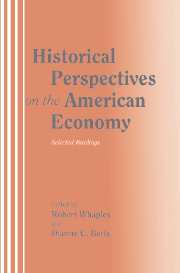Book contents
- Frontmatter
- Contents
- Acknowledgments
- Introduction to students
- Introduction to instructors
- Contributors
- I Introduction
- II Colonial and early national economy
- III Slavery and servitude
- IV The South since the Civil War
- V The rise of American industrial might
- VI Populism
- VII Women in the economy
- VIII The Great Depression
- 18 “Factors accounting for changes in the stock of money”
- 19 “The fall in the demand for money”
- Appendix: Basics of regression
- Glossary
- Name index
- Subject index
18 - “Factors accounting for changes in the stock of money”
Published online by Cambridge University Press: 05 June 2012
- Frontmatter
- Contents
- Acknowledgments
- Introduction to students
- Introduction to instructors
- Contributors
- I Introduction
- II Colonial and early national economy
- III Slavery and servitude
- IV The South since the Civil War
- V The rise of American industrial might
- VI Populism
- VII Women in the economy
- VIII The Great Depression
- 18 “Factors accounting for changes in the stock of money”
- 19 “The fall in the demand for money”
- Appendix: Basics of regression
- Glossary
- Name index
- Subject index
Summary
The factors accounting for changes in the stock of money during the four years from 1929 to 1933 are strikingly different from those in the other periods we have examined. Generally, the pattern for high-powered money has impressed itself most strongly on the total stock of money, the behavior of the two deposit ratios serving mainly to alter the tilt of the money stock relative to the tilt of high-powered money. That relation holds in Chart 1 only for the period up to October 1930, the onset of the first banking crisis. Thereafter, the two deposit ratios take command. High-powered money moves in a direction opposite to that of the total stock of money, and not even most of its short-term movements leave an impress on the stock of money.
From August 1929 to March 1933 as a whole, the change in highpowered money alone would have produced a rise of 17½ per cent in the stock of money. The change in the deposit-currency ratio alone would have produced a decline of 37 per cent; the change in the deposit-reserve ratio, a decline of 20 per cent; interaction between the two ratios, a rise of 10 per cent; these three converted the 17½ per cent rise that highpowered money would have produced into a 35 per cent decline in the stock of money. For a more detailed examination of these changes, we consider separately each of the periods distinguished in the preceding section and marked off on our charts.
- Type
- Chapter
- Information
- Historical Perspectives on the American EconomySelected Readings, pp. 576 - 595Publisher: Cambridge University PressPrint publication year: 1995



